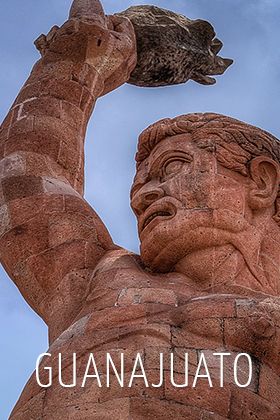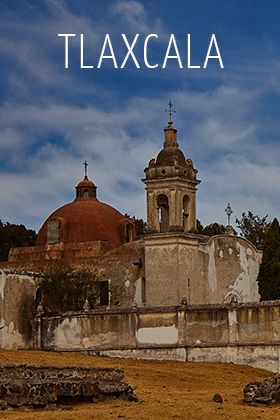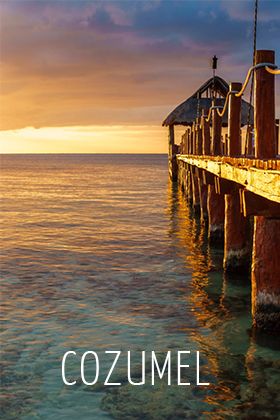About Puebla
by: Travel by México

About Puebla
by: Travel by México
The city of Puebla is one of the most notable historic jewels of Mexico, and a recognized banner of patriotism thanks to those who fought against the French invaders in the famous battle of 1862. Nevertheless, the fluctuations of such a rich past date back to a remote time, even before the days of splendor of Cholula, in what is the present day city of Puebla.
At the arrival of the Spanish conquerors, Cholula not only stood out as a commercial center, but also as the center for worship of the mythical Quetzalcoatl, an inspiration for many legends where man and god are joined together into one, embodied into one fantastical perspective. The pyramid of Cholula is believe it or not, the biggest in the world. With its 450 meters (1,476 ft) on each side, this enormous entity of rock edified by superimposed pyramids and dedicated to the god of rain Chiconahui Quiáhuitl, shows itself magnificently as the triumph of a lost faith, and simultaneously, as an architectural achievement of great proportions. In a journey through its ruins and alleys, one can observe the murals with multiple narrations and the displays of symbolic motifs, that serve as the one and only testimony of those who once gave life to this ancient ceremonial center.
And Puebla being a city of great magnetism, would not take long in becoming, through the passing of centuries, one of the most influential urban centers. It has as a foundation a rich architectural heritage, that is fed by a profound succession of traditions and cultural events with wonderful forms and colors.
In front of the zocalo stand the majestic towers of the Cathedral, both with a height of 69 meters (226 ft), and considered to be the tallest in the country. Francisco Becerra and Juan de Cigorondo were the original designers of this temple beginning in 1575. But with the arrival of Bishop Juan de Palafox y Mendoza in1640, the remodel began that would give the cathedral its current form that it holds today. A tour of the church to admire its colossal vaults and brilliant decor lasts approximately 30 minutes. But the cathedral is only the jumping off point for an extraordinary tour.
There are many other temples that represent artistic feats, loaded with refined elements and walls where one may imagine the tender yet visible connection between the past and present of such a noble city. We encounter the grand Iglesia de Santo Domingo, and the Capilla del Rosario (Rosary Chapel), of which the construction dates back to the second half of the 17th century, and which constitutes one of the greatest achievements of baroque novohispanic art. Its chapel is covered with stucco that is enveloped by a 22 karat golden plate. This qualifies without a doubt as one of the wonders of the world that will continue to live in the minds of generations to come.
And much there is to say also about the Iglesia de San Francisco located in the El Alto neighborhood, one of the oldest in the city of Puebla, or the Iglesia de San Francisco Acatepec on the federal highway of Cholula-Tonantzintla, a temple that is considered to be an authentic Mexican baroque work of art, with a facade that is masterfully covered with ceramic pieces, mostly Talavera china, handmade by 17th century ceramists from Puebla.
A tour through Puebla takes us all the way to the Loreto and Guadalupe Forts, that are preceded by a splendid arch, surviving from those that for centuries guarded the entrances to the Angelopolis. On the south face of the arch, the city’s emblem can be seen, and the patron of the arch, the archangel San Miguel, can be seen in the finish. Built on the hill many centuries ago, were a group of small churches, which later on were converted into chapels. Towards the end of the 17th century, the church of Loreto was reconstructed according to the tradition of the Casa de Loreto: the exterior walls encircled the interior chapel, sharing with it the ceiling and the one and only door, so that the exterior of the building surrounds the interior like a closed corridor.
Located in the old Plazuela de San Roque, built in 1801, is the Mercado de Artesanías El Parián. This local craft market is a place where tourists can delight in finding handmade objects from Talavera, onyx, glass, and clay. They can enjoy trying the local candy or buying clothes and textiles with incredible colors and embroideries. The Callejón de los Sapos (Alley of Toads), is an esplanade surrounded by typical royal houses, that serves as a meeting point for those who are out for a leisurely stroll. On this street there are antique bazaars, bars and restaurants, and the spirit of the mariachis and the bolero trios who wait in the plazuela to be hired, and sing to those who are celebrating love and life.
The famous Museo Amparo is dedicated to the memory of Senora Amparo Rugarcía de Espinosa Iglesias, who was the wife of a prominent business man from Puebla, and the founder and sponsor of this site. It is outstanding for how it adapts the colonial spaces for the exhibition of the artistic and archeological pieces. This museum contains invaluable pieces whose origins take us back to pre-hispanic times all the way to contemporary times, making it one of the most important museums in Latin America.
And have you heard of Puebla’s famous cuisine? In Puebla, there is the magnificent opportunity to taste some extremely special, different or simply exquisite flavors, with the seasoning of a closely guarded culinary tradition that was born out of two intermingled cultures, Spanish and Indigenous. And if that weren’t enough, in this tradition of flavors we find also Eastern and French influences, which make for one of the most varied and internationally recognized cuisines.



















